 |
 |
 |
 |
 |
|
|
to this page of unusual magic squares. New material will be added here as it becomes available and time permits. Enjoy! |
 |
A Pandiagonal Torus |
This pattern generates 50 order-5 pandiagonal magic squares. |
Magic Circles |
Two diagrams show characteristics of order-4. |
Square with Special Numbers |
Commemorates my Dad's 90th birthday. |
Prime Heterosquare |
Rivera's prime # squares have each line summing different. |
Double HH |
Ed Shineman constructed this order-16 with HH embedded. |
Shineman's Magic Diamonds |
Two magic diamond patterns with special numbers. |
Square with Embedded Star |
Arto Heino's order-8 contains a magic hexagon. |
Square to Star |
Heino's order-4 magic square converts to an order-8 star. |
Franklin's Order-8 |
Benjamin Franklin's order-8 semi-magic square. |
A Beastly Magic Square |
Patrick De Geest's Order-6 magic square sums to 666. |
Millennium Magic Square |
Shineman's order-16 pandiagonal with inlaid 2000. |
Sagrada Familia Magic Square |
A beautiful Spanish cathedral's magic square sums to 33. |
![]()
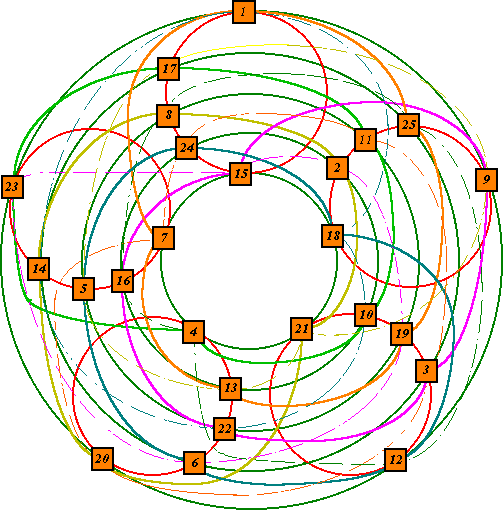 |
This pattern, which is a torus drawn in two dimensions may be used as an order-5 pandiagonal magic square generator. Examples: Start at number 2, and follow the big circles, to generate the columns of the B magic square. 25 different pandiagonal magic squares can be formed this way by starting with each of
the 25 numbers on the model.
|
Actually, four magic squares may be constructed by following the radial lines, and another four by following the spiral lines, in either direction around the torus. However, three of these magic squares are just disguised versions of the fourth one, because they are rotations or reflections.
|
 A 3-D model A 3-D model |
![]()
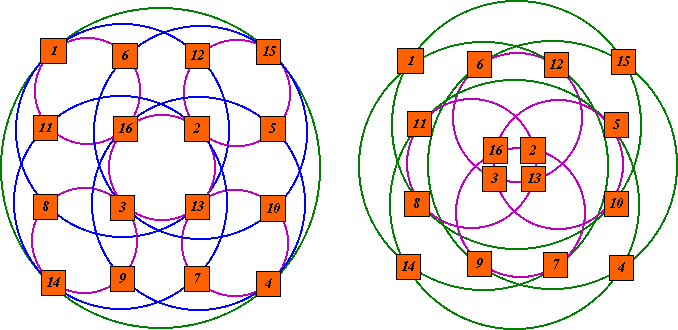
A. B.
These two diagrams, between them, illustrate some relationships in this order-4 magic
square.
1 6 12 15
A.
B.
11 16 2 5
1 + 15 + 4 + 14 -- biggest
circle
1 + 15 + 10 + 8 -- 1 of 4 big circles
8 3 13 10
1 + 12 + 13 + 8 -- 1 of 4
medium circles 11 + 2 + 13 + 8 --
1 of 4 small circles
14 9 7 4
1 + 6 + 16 + 11 -- 1 of 5 small circles
Thanks for the idea to W. S. Andrews, Magic Squares and Cubes, Dover, 1960.
![]()
|
I designed this pandiagonal magic square to commemorate my Dad's 90th
birthday. The three center numbers in the top row are his birth date, April 23/03. The 5
rows, 5 columns, the 2 main diagonals and the 10 broken diagonal pairs all sum to 90. Because this is also an Associative magic square, the corners of twenty-five 3 x 3 and twenty-five 5 x 5 squares, along with the center square in each case (including wrap-around) also all sum to 90. |
| There is still more! Corners of 25 2 x 2 rhombics along with the center cell of
each. Example: 17 + 4 + 49 + 8 + 12 = 90. Also 25 3 x 3, 4 x 4, and 5 x 5 rhombics (including wrap-around). An example of a 5 x 5 rhombic; 32 + 7 + 28 + 20 + 3 = 90. It is easier to visualize wrap-around if you lay out multiple copies of the magic square like a magic carpet. For still more patterns summing to 90, see my Deluxe magic square, although not all those patterns are possible because this is not a pure magic square. |
19 |
................... | 137 |
||||||||
5 |
41 |
13 |
59 |
31 |
37 |
41 |
109 |
|||
17 |
3 |
47 |
67 |
53 |
59 |
61 |
173 |
|||
7 |
83 |
11 |
101 |
67 |
43 |
47 |
157 |
|||
23 |
29 |
127 |
71 |
227 |
167 |
151 |
139 |
149 |
439 |
The Order-3 heterosquare on the left consists of 9 prime numbers. The 3 rows, 3 columns
and the 2 main diagonals all sum to different prime numbers. The sum of all 9 cells is
also a prime number.
Is this the square with the smallest possible total with eighteen
unique primes (including the totals)?
The Square on the right has identical features, but in addition consists of consecutive
primes.
Is this the square with the smallest possible total with nine
consecutive primes?
These squares designed by Carlos Rivera, Sept. 98. See his Web page on Prime Puzzles
& Problems at
http://www.sci.net.mx/~crivera/
![]()
98 |
79 |
178 |
95 |
162 |
63 |
194 |
47 |
210 |
255 |
2 |
239 |
18 |
143 |
114 |
159 |
158 |
179 |
78 |
163 |
94 |
195 |
62 |
211 |
46 |
3 |
254 |
19 |
238 |
115 |
142 |
99 |
100 |
77 |
180 |
93 |
164 |
61 |
196 |
45 |
212 |
253 |
4 |
237 |
20 |
141 |
116 |
157 |
155 |
182 |
75 |
166 |
91 |
198 |
59 |
214 |
43 |
6 |
251 |
22 |
235 |
118 |
139 |
102 |
101 |
76 |
181 |
92 |
165 |
60 |
197 |
44 |
213 |
252 |
5 |
236 |
21 |
140 |
117 |
156 |
153 |
184 |
73 |
168 |
89 |
200 |
57 |
216 |
41 |
8 |
249 |
24 |
233 |
120 |
137 |
104 |
103 |
74 |
183 |
90 |
167 |
58 |
199 |
42 |
215 |
250 |
7 |
234 |
23 |
138 |
119 |
154 |
151 |
186 |
71 |
170 |
87 |
202 |
55 |
218 |
39 |
10 |
247 |
26 |
231 |
122 |
135 |
106 |
105 |
72 |
185 |
88 |
169 |
56 |
201 |
40 |
217 |
248 |
9 |
232 |
25 |
136 |
121 |
152 |
149 |
188 |
69 |
172 |
85 |
204 |
53 |
220 |
37 |
12 |
245 |
28 |
229 |
124 |
133 |
108 |
107 |
70 |
187 |
86 |
171 |
54 |
203 |
38 |
219 |
246 |
11 |
230 |
27 |
134 |
123 |
150 |
148 |
189 |
68 |
173 |
84 |
205 |
52 |
221 |
36 |
13 |
244 |
29 |
228 |
125 |
132 |
109 |
110 |
67 |
190 |
83 |
174 |
51 |
206 |
35 |
222 |
243 |
14 |
227 |
30 |
131 |
126 |
147 |
146 |
191 |
66 |
175 |
82 |
207 |
50 |
223 |
34 |
15 |
242 |
31 |
226 |
127 |
130 |
111 |
112 |
65 |
192 |
81 |
176 |
49 |
208 |
33 |
224 |
241 |
16 |
225 |
32 |
129 |
128 |
145 |
160 |
177 |
80 |
161 |
96 |
193 |
64 |
209 |
48 |
1 |
256 |
17 |
240 |
113 |
144 |
97 |
This is an Order-16 pandiagonal pure magic square so uses the consecutive numbers from
1 to 256.
Each of the 16 rows, columns, and diagonals sum to the constant 2056
The E. S. each also sum to 2056 and the H. H. each sum to 2056 x 2.
Constructed in Sept./98 by E.W. Shineman, Jr. for myself. Thanks Ed.
![]()
Update: Sept. 14, 2001
After investigating the Franklin 16x16 squares, I did the same tests on this one. Here are
the results of that test.
If there are 16 cells in the pattern, they sum to S. If there are
only 4 cells to a pattern, their sum is S/4, and 8 cell patterns produce S/2.
The word ‘All’ with no qualifier means that the pattern may be started at ANYof
the 256 cells of the magic square.
| All rows of 16 cells. All columns of 16 cells. All rows of 8 cells starting on EVEN columns All columns of 8 cells starting on rows 8 & 16 All rows of 4 cells starting on EVEN columns All columns of 4 cells starting on rows 2 & 10 All rows of 2 cells starting on EVEN columns All 16 cell diagonals All 2x2 square arrays Corners of all even squares All 16 cell small patterns (fully symmetrical within a 6x6 or 8x8 square array) All 16 cell midsize patterns (fully symmetrical within a 10 or 12 square array) All 16 cell large patterns (fully symmetrical within a 14 or 16 square array) All horizontal 2-cell segment bent-diagonals All vertical 2-cell segment bent-diagonals, R, L starting on ODD rows All vertical 2-cell segment bent-diagonals, L, R starting on EVEN rows All horizontal 4-cell segment bent-diagonals starting in column 4, 8, 12 and 16 All vertical 4-cell segment bent-diagonals starting in column 2, 6, 10, 14 NO 8-cell segment (regular) bent-diagonals All knight-move horizontal 8-cell segment, bent-diagonals All knight-move vertical 8-cell segment, bent-diagonals |
See more on the Franklin page
![]()
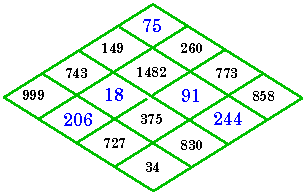 Constructed by E. W. Shineman, Jr. , treasurer, to commemorate his company's
75th (Diamond) Anniversary in 1966. It
contains 5 special numbers.
Constructed by E. W. Shineman, Jr. , treasurer, to commemorate his company's
75th (Diamond) Anniversary in 1966. It
contains 5 special numbers.
75 The anniversary.
18 & 91 1891 The year the company was founded.
206 Net sales in 1966 (millions of dollars).
244 Net earnings (cents per share).
24 combinations of 4 numbers sum to 1966.
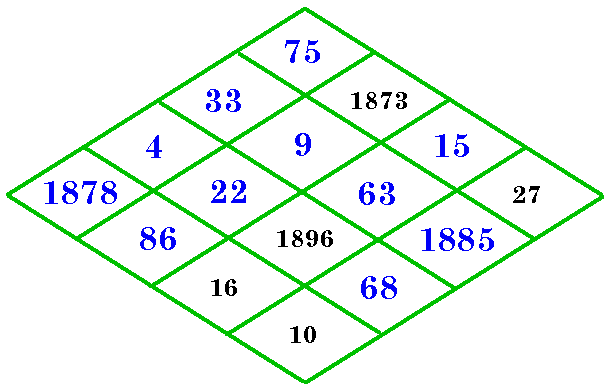 Also constructed by E. W. Shineman, Jr., this in 1990 for his 75th birthday.
Also constructed by E. W. Shineman, Jr., this in 1990 for his 75th birthday.
This one contains 11 special numbers.
75 Age on reaching diamond anniversary.
33 (1933) Year graduated from high school.
4-9-15 Date of birth.
1878 Year father was born.
22 Age when graduated from college
86 (1886) Birthyear of Father-in-law &
mother-in-law
1885 Year mother was born.
63 & 68 (1963 &1968) Years of career milestones
24 combinations of 4 numbers sum to 1990.
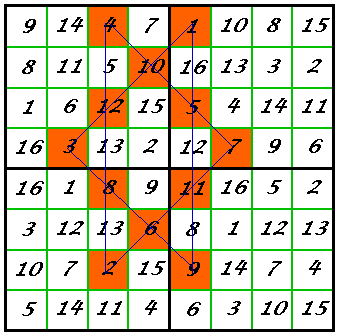 This order-8 magic square is composed of four order-4 pure magic squares. The
embedded magic star is index # 16 and is super-magic (the points also sum to the constant
34).
This order-8 magic square is composed of four order-4 pure magic squares. The
embedded magic star is index # 16 and is super-magic (the points also sum to the constant
34).
The index numbers of the magic squares are:
upper left # 390 equivalent upper right # 142 the basic solution
lower left # 724 equivalent lower right # 271 equivalent
The equivalent solutions require rotations and/or reflections in order to match the basic
solution # shown.
Frénicle, assigned these magic square index numbers about 1675, when he published a
list of all 880 basic solutions for the order-4 magic square. For more information, see
Benson & Jacoby, New Recreations with Magic Squares, Dover Publ., 1976.
The magic star index numbers were designed and assigned by me and a full description appears at Magic Star Definitions.
Thanks to Arto Juhani Heino who e-mailed me this pattern on Jul. 15/98.
![]()
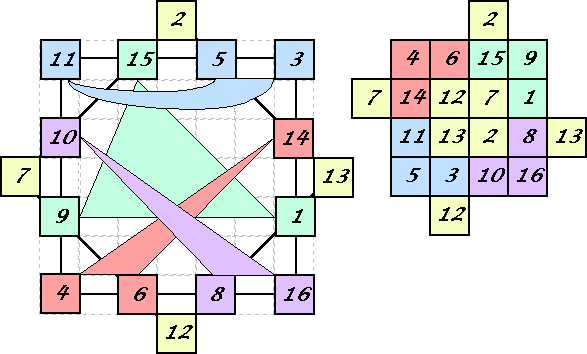
This diagram shows some relationships between an order-8B magic star and an order-4
magic square.
Both patterns are basic solutions. The star is index # 57 (Heinz) and the square is index
# 666 (Frénicle).
Thanks to Arto Juhani Heino for this design.
![]()
|
This magic square was constructed by Benjamin Franklin (1706-1790). It has many interesting properties as illustrated by the following cell patterns. Because the square is continuous, (wraps around), each pattern is repeated 64 times ( 8 in each direction). However, because the main diagonals do not sum correctly (one totals 260 - 32 & the other 260 + 32), it is not a true magic square. |
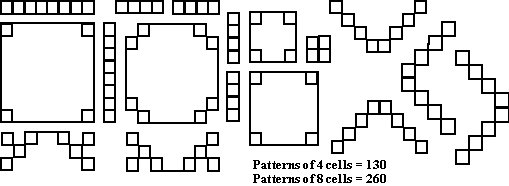 |
Franklin also constructed an order-16 magic square with similar properties. It also has the property that any 4 by 4 square sums to the constant, 2056, as well as some other combinations. See my Franklin page for more on all of Ben Franklin squares (and his magic circle) |
![]()
| This order-6 magic square is constructed from the first 36 multiples of 6, and has a magic sum of 666.
I received this beastly square from |
This square contains many hidden 3-digit palindromes (which I indicate here in blue). The top left 3 by 3 square is magic with S = 252. The bottom left 3 by 3 square is magic with S = 414. The 3 row of 3 cells in top right corner sum to 414. The 3 row of 3 cells in bottom right corner sum to 252. The corners of the 3 squares working from the outside to the center, each sum to 444. The 6 by 6 border cells sum to 2220 which equals 666 + 888 + 666. The border cells of the central 4 by 4 square sum to 1332 which equals 666 + 666. The top half of the right-hand column sums to 252 and the bottom half to 414. The top half of the column next to it sums to 414 and the bottom half to 252. By dividing each number in the magic square by 6, a new magic square is obtained, with S = 111. What other features still await discovery? |
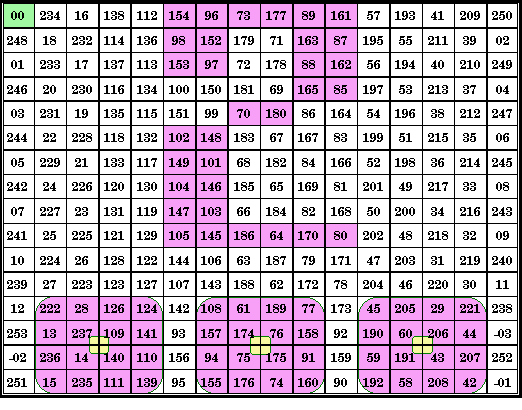 |
Edward W. Shineman, Jr. designed this magic square to commemorate the
start of the new century (and millenium). It is an order 16 pandiagonal using numbers from –3 to 253 with one number not used. (Can you find the missing number?) Each row, column and
diagonal, including the broken diagonal pairs, sum to 2000. In addition, the three groups
of sixteen numbers (the zeros) each sum to 2000. |
NOTE: There is controversy as to whether the year 2000 is part of the 20th or the 21st century (and the 2nd or 3rd millennium). Here we consider it to be the latter.
The Sagrada Familia cathedral in Barcelona, Spain,
contains the unusual magic square shown in the two pictures below.
Both the number 10 and the number 14 are repeated twice and there is no 12 or 16. The
magic sum is 33.
Does anyone know the significance of this magic square?
Many people have speculated that 33 signifies
Jesus Christ's age at the time of his crucifixion.
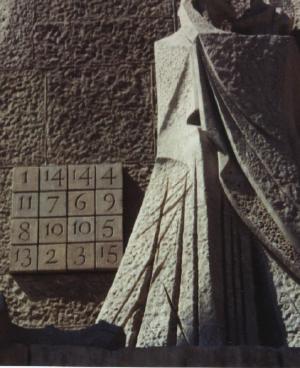 |
These pictures were taken by
Jorge Posada and are dedicated to his girlfriend Maite. Thank you Jorge,
for the pictures and for drawing this item to my attention. The picture below shows the placement in the cathedral but is of unknown origin.
Alex Cohn (e-mail July 15/01) points out that this square also appears multiple times on the main facade of the incompleted church. |
The Sagrada Familia cathedral is the most important work of Gaudi, a spanish architect considered as a true genius. He worked on this building from 1882 until his death in 1926. Although it is not completed yet, it is the most important and amazing building in Barcelona. It has no roof so far, for instance, but there is a saying in Barcelona: "The only worthy roof for the Sagrada Familia is the sky". There is some information about the cathedral in: http://www.greatbuildings.com/buildings/Sagrada_Familia.html
![]()
Lee Sallows (July12,2001) points out that magic squares
with a magic sum of 33 may be constructed without using duplicate integers. |
|
Please send me Feedback about my Web
site!![]()
![]()

![]()

Harvey Heinz harveyheinz@shaw.ca
This page last updated
October 06, 2005
Copyright © 1998, 1999, 2000 by Harvey D. Heinz